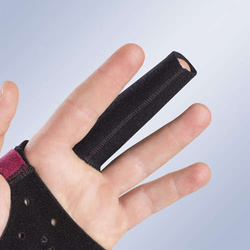Finger splints and hand support
( number of products: 29 )Treat hand and finger injuries with finger splints
Our hands are an essential part of our everyday lives, and injuries to the fingers and carpal bones can be painful and can make daily functioning difficult. In order to effectively treat these delicate parts of our body, speak with a doctor or physiotherapist and have them recommend a proper finger splint for you.
Finger splints - who are they for?
Typically, a finger splint is used for treating injuries to the fingers by immobilizing one or several at a time, and in some cases even the metacarpal and carpal bones. For this reason, a finger brace can actually help stiffen the hand when treating sprains and some types of fractures. Additionally, a finger splint can help treat inflamed joints as well.
Splints may also be used after surgery to protect the skin from damage and stabilize the seams until they are fully healed. In some cases, the splint may counteract tendon adhesions after more complicated procedures.
How does a finger splint work?
A finger splint is intended to immobilize the finger in a specific position. This is important in both the treatment of the finger itself, as well as in treating injuries to the tendons or metacarpal bones. Further damage and bone displacement is prevented, consequently allowing for a faster recovery. Additionally, such products can help to immobilize and stabilize the finger into the correct position if you don’t have control over it. In such cases, it is best that the patient wears their finger splints during sleep to ensure finger health.
Finger splints are also known to relieve pain caused by built up pressure being exerted in the hand. Well-chosen products can help significantly reduce the pain that often occurs during the rehabilitative process, which can take quite a while. With the help of your brace however, chances are you’ll be able to reduce the number of painkillers you may be taking during the recovery process.
The types of finger braces
Depending on which products you may be interested in, you’ll be able to choose from an assortment of rigid and flexible products, as well as ones with an adjustable angle of inclination. These finger splints are all designed to help you recover from specific injuries, which is why it is important that you first speak with an orthopedist or physiotherapist before making a decision.
A well-chosen finger splint is comfortable to wear and is a certified medical product, which ensures that it is not only safe, but also provides therapeutic benefits. Only certified finger splints are the only acceptable product for treating injuries to the fingers and wrist.
The products are made of sanitary materials that are easy to clean and safe for the skin. They do not cause irritation or discomfort - even after prolonged use.

Combination of coiled spring wire Oppenheimer to dorsiflex the wrist with composite elastic splint to extend the MP and PIP joints

Combination of coiled spring wire Oppenheimer to dorsiflex the wrist with reverse knuckle bender to extend the metacarpophalangeal joints

Composite spring and elastic splint to extend the distal interphalangeal joints

DeRoyal finger spring 501,extension assist, metacarpal phalangeal/proximal interphalangeal extension

inger knuckle bender splint to flex the proximal interphalangeal joints

Knuckle bender splint to flex the metacarpophalangeal joints with outrigger to extend the distal joints

Low profile foam and wire PIP Extension Post injury joint stiffness
- 1
- 2













